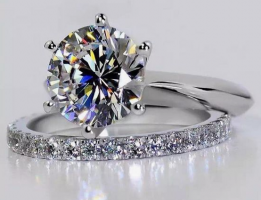Over the longer term diamond prices have consistently increased, so many people have considered them as an investment. When it comes to buying a stone for investment, the secret is in the planning. Here are 7 things you need to consider before you purchase.
Over the longer term diamond prices have consistently increased, so many people have considered them as an investment. When it comes to buying a stone for investment, the secret is in the planning. Here are 7 things you need to consider before you purchase.
1. Buy a piece you like
Ask yourself, are you buying primarily for investment or personal pleasure? If the answer is investment, it’s important to note that this will be more long term. You will need to wait 5-10 years to capitalise on reselling. Diamonds are not the kind of investment that earns you an income. For this reason, it’s wise to choose an item that you like. Then your income becomes the joy you get from wearing the piece.
2. Choose a carat, colour and clarity that’s in demand
When buying with an ultimate goal to resell, choose a diamond you predict will increase in demand. Surprisingly, this doesn’t always mean you have to find something unusual or even a stone with exceptionally high colour and clarity. Larger-size diamonds are in demand as well as being in short supply. Stones over 2 carats with high colour or clarity make a good choice. Fancy colour diamonds should be considered, too. Choosing a type of diamond that is in high demand makes it easier to resell later.
3. Do your market research
Take the time to shop around to ensure you’re getting value for money. Know your price points in relation to the colour, clarity, cut and carat weight. This way you can be sure that you are buying at a price that will maximise your investment later. Buying at auction is a good idea because it means you avoid the margin included in retail prices.
4. Certification / authenticity
First State Auctions Director, Ari Taibel, has been in the jewellery auction business for over twenty five years. He says, “If I were to advise people on buying a diamond for investment, probably one of the most important things would have to be a well-regarded laboratory report. You need a report from a laboratory that’s recognised within the market that you are intending to sell. This makes sure that the quality of the diamond is recognised when it comes time to resell.” If you’re thinking of selling in Australia, GIA and GSL are both reputable grading institutions known for their strict grading standards. If you are thinking of selling overseas, GIA is your best bet, being internationally recognised. A certificate gives your potential buyer confidence that they are getting what they are paying for.
5. Consider your outlets for reselling
If you’re buying to make money, you need to measure up the various different ways you can sell your pieces. Having a network of private clients, either in person or online, in Australia or overseas, is a good option. For example, some investors take their goods to China in order to resell them. In China there is a price differential and a high demand, making this a strong market.
6. Calculate the costs involved in buying and selling
If you don’t have your own network within which to sell, you may need to commission someone to do this on your behalf. Identifying these and other costs before you purchase will help you gauge the practicality of your investment.
7. Avoid treated diamonds
If a diamond is colour-treated, fracture-filled, or laser-drilled, its value is greatly reduced and difficult to resell. Not only are they lower in value, they are less appealing to potential buyers. For this reason, First State Auctions only sells natural diamonds and gemstones. This takes us back to the need to get appropriate certification. A certificate from GIA, GSL or the like will pick these treatments up BEFORE you commit your cash. In short, purchasing a piece for personal pleasure that has genuine demand within the market is the safest way to buy for investment. Plus, it has the added benefit of bringing you a little sparkle to your life!
8. Avoid lab-grown diamonds
Lab-grown diamonds (also known as synthetic diamonds) are produced in a laboratory or factory. The technology for producing lab-grown diamonds is constantly evolving and improving. This means that the cost of production has decreased over time and is likely to continue. Natural diamonds can appreciate due to their scarcity and rarity, whereas lab-grown diamonds are easier to produce, which can lead to oversupply and lower prices. The resale market for lab-grown diamonds is limited, and leading luxury goods auctioneers do not sell lab-grown diamonds.

